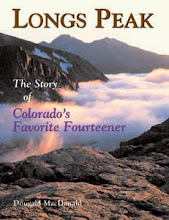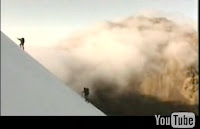 There's a ten-pack of escapist fantasy at Travercial, as the travel video site presents its top ten short vids of 2007. These have the slick look of tourism-bureau infomercials, not home movies, and there's plenty to whet the travel appetite from Bostwana, Tibet, Thailand, and other hotspots you wish you were visiting right now instead of waiting for a flight to Cleveland to visit the in-laws.
There's a ten-pack of escapist fantasy at Travercial, as the travel video site presents its top ten short vids of 2007. These have the slick look of tourism-bureau infomercials, not home movies, and there's plenty to whet the travel appetite from Bostwana, Tibet, Thailand, and other hotspots you wish you were visiting right now instead of waiting for a flight to Cleveland to visit the in-laws.
Monday, December 24, 2007
Monday Morning Time Waster
Posted by
Dougald MacDonald
at
8:36 AM
0
comments
![]()
![]()
Friday, December 21, 2007
Out of the Ashes
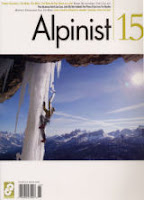 Ever since a fire destroyed Alpinist’s inventory of back issues, calendars, water-bottle premiums and the like in early December, the magazine has offered a case study of effective PR and disaster response. The fire story and request for support through subscription purchases has been picked up by websites around the world, from Outside to Supertopo, Planet Mountain (Italy) to Mountain.ru (Russia). Even Climbing.com, one of my employers and a rival of Alpinist, ran a sympathetic home-page story, complete with links and the line: “If you were considering giving Alpinist as a gift or renewing your subscription, now's a great time to do so.”
Ever since a fire destroyed Alpinist’s inventory of back issues, calendars, water-bottle premiums and the like in early December, the magazine has offered a case study of effective PR and disaster response. The fire story and request for support through subscription purchases has been picked up by websites around the world, from Outside to Supertopo, Planet Mountain (Italy) to Mountain.ru (Russia). Even Climbing.com, one of my employers and a rival of Alpinist, ran a sympathetic home-page story, complete with links and the line: “If you were considering giving Alpinist as a gift or renewing your subscription, now's a great time to do so.”
What’s going on here? Some of this is a genuine outpouring of support for people who work hard at a small business and have had a serious setback. (I’m buying an Alpinist calendar that I probably wouldn’t buy otherwise; I’m already a subscriber.) Some of it is the perennial enthusiasm of magazine and website editors for writing about other magazines. Some of it reflects the huge reserve of good will that Alpinist has developed with its high-class publication.
But Alpinist also managed this disaster superbly:
• The magazine broke the story itself, on its website.
• They kept a positive tone (no one was injured; the support from the climbing community is gratifying; “we’ve put far too much work into Alpinist to let a fire slow us down.”)
• They asked for help, as a “favor”: subscribe, give a subscription, buy a calendar.
On balance, I’m sure Alpinist would much prefer the fire had never happened. But the magazine’s response to the disaster is likely to yield long-term benefits, and it offers lessons for all business managers.
Posted by
Dougald MacDonald
at
6:53 AM
0
comments
![]()
![]()
Thursday, December 20, 2007
Return of the Warthog
 Pound-in ice protection hasn't been used much in North America for more than a decade, ever since high-quality, easy-in/easy-out ice screws eliminated the need for desperation pieces like the Snarg on vertical ice. But in Britain and parts of Europe, where frozen turf—en route and on the tops of crags—is a big part of the game, drive-ins still have their place. The venerable Warthog, a drive-in/screw-out piton, hadn't been manufactured in a couple of years, but the British retailer Needle Sports is bringing them back: "The Warthog Ice Screw was first made by Salewa, but as far as we can ascertain Mountain Technology were the only company that have produced them in recent years. With the demise of Mountain Technology, and their parent company HB, the Warthog, so beloved of British and Polish climbers but so little known elsewhere, looked like becoming an endangered species. However, Needle Sports has located the engineering firm that originally made Warthogs for Mountain Technology and are very pleased to be able to offer them once again."
Pound-in ice protection hasn't been used much in North America for more than a decade, ever since high-quality, easy-in/easy-out ice screws eliminated the need for desperation pieces like the Snarg on vertical ice. But in Britain and parts of Europe, where frozen turf—en route and on the tops of crags—is a big part of the game, drive-ins still have their place. The venerable Warthog, a drive-in/screw-out piton, hadn't been manufactured in a couple of years, but the British retailer Needle Sports is bringing them back: "The Warthog Ice Screw was first made by Salewa, but as far as we can ascertain Mountain Technology were the only company that have produced them in recent years. With the demise of Mountain Technology, and their parent company HB, the Warthog, so beloved of British and Polish climbers but so little known elsewhere, looked like becoming an endangered species. However, Needle Sports has located the engineering firm that originally made Warthogs for Mountain Technology and are very pleased to be able to offer them once again."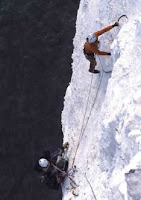 I've still got an old CAMP Warthog in my gear pile, more for sentimental than practical reasons. If you needed a drive-in today, a poundable hook like the Spectre would almost always be a better bet. But there's one situation where Warthogs were truly useful: "ice climbing" on the chalk cliffs near Dover, England, a dubious practice invented by desperate Londoners who lived 12 hours from the nearest Scottish ice. I did several climbs at Dover in the mid-’80s, and Warthogs (along with concrete rebar) provided remarkably solid pro, though they were a bear to place. Check out the photos and story on Vince Anderson's site to get a feel for this bizarre game.
I've still got an old CAMP Warthog in my gear pile, more for sentimental than practical reasons. If you needed a drive-in today, a poundable hook like the Spectre would almost always be a better bet. But there's one situation where Warthogs were truly useful: "ice climbing" on the chalk cliffs near Dover, England, a dubious practice invented by desperate Londoners who lived 12 hours from the nearest Scottish ice. I did several climbs at Dover in the mid-’80s, and Warthogs (along with concrete rebar) provided remarkably solid pro, though they were a bear to place. Check out the photos and story on Vince Anderson's site to get a feel for this bizarre game.
Anyway, I'm keeping my old Warthog. Who knows how long they'll be made, and maybe I'll go back to Dover someday. Maybe I'll need to hang something heavy from a beam in the garage. Maybe I just like having one on my rack.
Posted by
Dougald MacDonald
at
8:21 AM
0
comments
![]()
![]()
Wednesday, December 19, 2007
Peruvian Flakes
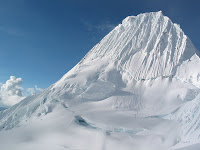 Chris Davenport, the guy who skied all of Colorado’s fourteeners in a single year, has big, big plans for 2008. First up is skiing all of the California fourteeners (there are 12 to 15, depending how you count—I’m not sure how Davenport is counting). If he succeeds, he’ll be the only person to ski all the fourteeners in the Lower 48. But that’s just the warm-up. He also wants to ski several of the iconic peaks of the Alps, including the west face of the Eiger, the east face of the Matterhorn, Mont Blanc, and Monte Rosa. And his wildest goal is skiing Alpamayo, the 19,511-foot peak in the Cordillera Blanca that’s sometimes called the most beautiful mountain in the world. Alpamayo (in photo) has not been skied before. Anyone want to guess why?
Chris Davenport, the guy who skied all of Colorado’s fourteeners in a single year, has big, big plans for 2008. First up is skiing all of the California fourteeners (there are 12 to 15, depending how you count—I’m not sure how Davenport is counting). If he succeeds, he’ll be the only person to ski all the fourteeners in the Lower 48. But that’s just the warm-up. He also wants to ski several of the iconic peaks of the Alps, including the west face of the Eiger, the east face of the Matterhorn, Mont Blanc, and Monte Rosa. And his wildest goal is skiing Alpamayo, the 19,511-foot peak in the Cordillera Blanca that’s sometimes called the most beautiful mountain in the world. Alpamayo (in photo) has not been skied before. Anyone want to guess why?
Posted by
Dougald MacDonald
at
6:31 AM
5
comments
![]()
![]()
Tuesday, December 18, 2007
X-Treme
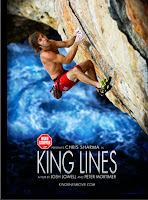 If you liked King Lines, the mind-boggling, award-sweeping Josh Lowell and Peter Mortimer film about Chris Sharma, but wished someone would produce a similar film about traditional routes, well, you’re in luck. In 2008, Mortimer's Sender Films will focus on the world's boldest ascents to produce The Sharp End, which will headline next fall’s Reel Rock Tour. Mortimer, who made the film Scary Faces about Eldorado Canyon's legendary Jules Verne route, has long had an eye for dangerous climbing, and he knows how to tell a good story. With the success of King Lines and other recent Sender films, he now has the financial resources to apply his skills worldwide. When The Sharp End appears, they'll have to put chalk in the theaters to deal with all the sweaty palms.
If you liked King Lines, the mind-boggling, award-sweeping Josh Lowell and Peter Mortimer film about Chris Sharma, but wished someone would produce a similar film about traditional routes, well, you’re in luck. In 2008, Mortimer's Sender Films will focus on the world's boldest ascents to produce The Sharp End, which will headline next fall’s Reel Rock Tour. Mortimer, who made the film Scary Faces about Eldorado Canyon's legendary Jules Verne route, has long had an eye for dangerous climbing, and he knows how to tell a good story. With the success of King Lines and other recent Sender films, he now has the financial resources to apply his skills worldwide. When The Sharp End appears, they'll have to put chalk in the theaters to deal with all the sweaty palms.
Posted by
Dougald MacDonald
at
9:28 AM
1 comments
![]()
![]()
Monday, December 17, 2007
Long Dong Climbs
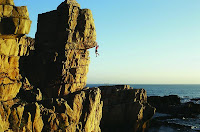 I’d never seriously considered visiting Taiwan for rock climbing, but after seeing these photos from the sea cliffs of Long Dong (aka Lung Tung), it’s officially on the list.
I’d never seriously considered visiting Taiwan for rock climbing, but after seeing these photos from the sea cliffs of Long Dong (aka Lung Tung), it’s officially on the list. 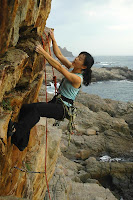 The pics are from the website of Matt Robertson, a U.S. expat who published the guidebook to trad climbs in the area last year. More than 500 climbs, up to 5.13c, ascend dozens of solid sandstone cliffs, just 30 minutes from Taipei City.
The pics are from the website of Matt Robertson, a U.S. expat who published the guidebook to trad climbs in the area last year. More than 500 climbs, up to 5.13c, ascend dozens of solid sandstone cliffs, just 30 minutes from Taipei City. 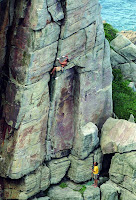 Though many of the routes are bolted, Robertson focused on traditionally protected routes, some of which look as good as Britain’s finest sea-cliff climbs. Even on sport routes, it seems, carrying a rack of gear is a good idea—bolts rust rapidly in the seaside environment. Looks like fun!
Though many of the routes are bolted, Robertson focused on traditionally protected routes, some of which look as good as Britain’s finest sea-cliff climbs. Even on sport routes, it seems, carrying a rack of gear is a good idea—bolts rust rapidly in the seaside environment. Looks like fun!
Posted by
Dougald MacDonald
at
7:06 AM
0
comments
![]()
![]()
Saturday, December 15, 2007
Trivia Challenge
HBFC. These initials adorned the helmet of a well-known American climber from the 1960s. Anyone know what they stand for?
Posted by
Dougald MacDonald
at
5:52 PM
6
comments
![]()
![]()
Wednesday, December 12, 2007
Drop Zone
 Over the years, I've put up a fair number of routes, and many of them have stunk. Unless you're A) a really good climber or B) have a lot of free time, it's damn hard to find good new routes and climb them. About a decade ago, I had A) lots of free time (between jobs), and B) a really good climber with me, in the person of Chris McNamara. We had never met, but we agreed over the phone to try a new line I had spotted in Zion. We climbed 11 pitches over four or five days at Thanksgiving (new aid routes are slow going) and called it Drop Zone. I thought it was pretty darn good.
Over the years, I've put up a fair number of routes, and many of them have stunk. Unless you're A) a really good climber or B) have a lot of free time, it's damn hard to find good new routes and climb them. About a decade ago, I had A) lots of free time (between jobs), and B) a really good climber with me, in the person of Chris McNamara. We had never met, but we agreed over the phone to try a new line I had spotted in Zion. We climbed 11 pitches over four or five days at Thanksgiving (new aid routes are slow going) and called it Drop Zone. I thought it was pretty darn good.
So, I was psyched to see the route get repeated this fall (maybe the second ascent) and written up in a very funny and well-illustrated trip report at Supertopo. I was even more tickled to learn that "Yo," the author of this report, was actually Ryan Frost, son of the great Yosemite pioneer Tom Frost.
More sappy sentimentality here.
Posted by
Dougald MacDonald
at
2:02 PM
0
comments
![]()
![]()
Friday, December 07, 2007
Suddenly I See...Blackened Fingertips
 Scottish singer KT Tunstall reportedly has decided to give up climbing because of the fear of frostbite damaging her guitar-playing fingers. "I love the mountains, but I'm also aware of the dangers they present," she told reporters. Tell me about it. I had to give up my singing career because of the fear that I would damage my ability to shout "Up rope!"
Scottish singer KT Tunstall reportedly has decided to give up climbing because of the fear of frostbite damaging her guitar-playing fingers. "I love the mountains, but I'm also aware of the dangers they present," she told reporters. Tell me about it. I had to give up my singing career because of the fear that I would damage my ability to shout "Up rope!"
Posted by
Dougald MacDonald
at
6:41 AM
1 comments
![]()
![]()
Friday Morning Time-Waster: Slow is Safe
Tip of the hat to Splitter Choss for pointing out this one from last winter. Like a lot of homemade vids, this one drags a bit, but the first couple of minutes are priceless. Question: If four tools are safe, wouldn't six be safer?
Posted by
Dougald MacDonald
at
6:01 AM
1 comments
![]()
![]()
Wednesday, December 05, 2007
You Gotta Get In to Win
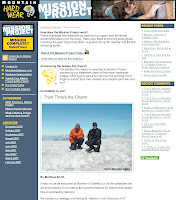 Tis the season for giving, but today I want to talk about getting. Or, rather, winning. I’ve never had much luck with the lottery, but it turns out that it's a lot easier to win outdoor-industry contests and giveaways, and with companies eager to draw traffic to their websites and e-letters, new ones are popping up all the time.
Tis the season for giving, but today I want to talk about getting. Or, rather, winning. I’ve never had much luck with the lottery, but it turns out that it's a lot easier to win outdoor-industry contests and giveaways, and with companies eager to draw traffic to their websites and e-letters, new ones are popping up all the time.
Last summer I submitted an entry to Mountain Hardwear’s Mission Project blog after the company was nice enough to provide me with a lightweight Phantom 32 sleeping bag. I can bang out a trip report like this before my second cup of coffee—no big deal. So I was blown away when I learned a few weeks later that my entry had been chosen to win a $1,000 shopping spree for Mountain Hardwear gear. The blog is still seeking entries, and it’s not too late to submit your own; you'll be eligible to win a guided trip up Mt. Rainer and a $2,000 gear spree. My good fortune was nothing compared with the artist Jeremy Collins and his brother, Jonathan, who entered a Zest soap competition and then shamelessly lobbied friends to vote for them. Jer wrote up the entry for his brother, who proceeded to win $15,000 worth of travel. The two have already used part of the money to visit the Lofoten Islands in Norway and are planning to use the rest to travel to Patagonia and China. As if that isn’t enough, they also were named Mr. February and Mr. March for the “Zest Men of Adventure” calendar.
My good fortune was nothing compared with the artist Jeremy Collins and his brother, Jonathan, who entered a Zest soap competition and then shamelessly lobbied friends to vote for them. Jer wrote up the entry for his brother, who proceeded to win $15,000 worth of travel. The two have already used part of the money to visit the Lofoten Islands in Norway and are planning to use the rest to travel to Patagonia and China. As if that isn’t enough, they also were named Mr. February and Mr. March for the “Zest Men of Adventure” calendar.
These things are everywhere:
• The Gear Junkie (aka Stephen Regenold) gives away a really nice bit of schwag every week, just for signing up to receive its e-newsletter.
• Climbing magazine is offering a free trip to the Gunks, with a stay at the exclusive Mohonk Mountain House and the chance to climb at the off-limits Skytop crag.
• Kayland and Rock and Ice are giving away a pair of boots to the person who writes the best 75-word “essay” on his or her best climbing partnership.
• Polarguard is offering a pile of schwag every two months to people who write the best adventure story for its website.
Many of these contests expire soon, but more will be on their way. And unlike your chances in Powerball, your odds of winning one of these outdoor-industry giveaways are really, really good. As I learned painfully when I ran a climbing magazine for five years, the outdoor market is teeny. And the number of people who will actually get off their butts and scribble a 10-minute trip report is even smaller. Bottom line: You don’t have to be Jon Krakauer or Jimmy Chin to score big with your writing or photography.
Posted by
Dougald MacDonald
at
11:45 AM
1 comments
![]()
![]()
Tuesday, December 04, 2007
Eiger Tales
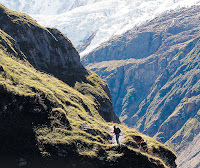 My story about hiking around the Eiger during September’s trip to Switzerland headlined the travel section in Sunday’s Denver Post . A nice surprise for me: They ran a nearly full-page version of my photo from our hike to the Bäregg Hut.
My story about hiking around the Eiger during September’s trip to Switzerland headlined the travel section in Sunday’s Denver Post . A nice surprise for me: They ran a nearly full-page version of my photo from our hike to the Bäregg Hut.
It’s always a delight when one of my photos is published, because I don’t consider myself a professional photographer. But even if I never sold a photo, I’d still carry a camera whenever I traveled, and especially when I was working. For a journalist—or any traveler who wants to remember as much as possible—a small digital camera is invaluable. I use it to capture the text on signs and documents, saving me the trouble of taking notes; I refer to my photos when writing to recall details that otherwise might be forgotten; I’ll even shoot a short video so I can see and hear the person whose words are recorded in my notebook. And every now and then, I sell a photo too.
Posted by
Dougald MacDonald
at
6:51 AM
2
comments
![]()
![]()
Monday, December 03, 2007
Maxi-Pads
 Pads have revolutionized bouldering, allowing the average climber to attempt high and hard problems once reserved for the lunatic fringe. So, what's next? The maxi-pad.
Pads have revolutionized bouldering, allowing the average climber to attempt high and hard problems once reserved for the lunatic fringe. So, what's next? The maxi-pad. • 8a.nu, the Swedish megasite for sport climbing and bouldering news, has introduced an inflatable pad that measures nearly 7 feet by 4 feet and provides 8 inches of air-conditioned crash protection. When you're not whipping onto it, you can use the Air Pad as a double bed. Or a life raft. Cost: 395 euros.
• 8a.nu, the Swedish megasite for sport climbing and bouldering news, has introduced an inflatable pad that measures nearly 7 feet by 4 feet and provides 8 inches of air-conditioned crash protection. When you're not whipping onto it, you can use the Air Pad as a double bed. Or a life raft. Cost: 395 euros.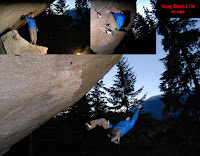 • Squamish climber Matt Maddaloni rigged a 30-foot-diameter trapeze net, fashioned from fishing net and industrial-strength bungy cord, to protect his attempts to free-solo a 5.13a route. Says Maddaloni: "I never did finish the route—the crux takes you out near the edge of the net—but it was sure fun taking huge whippers into space on your back." Cost: A full day of rigging that might have been spent doing, well, almost anything else.
• Squamish climber Matt Maddaloni rigged a 30-foot-diameter trapeze net, fashioned from fishing net and industrial-strength bungy cord, to protect his attempts to free-solo a 5.13a route. Says Maddaloni: "I never did finish the route—the crux takes you out near the edge of the net—but it was sure fun taking huge whippers into space on your back." Cost: A full day of rigging that might have been spent doing, well, almost anything else.
Posted by
Dougald MacDonald
at
12:42 PM
0
comments
![]()
![]()
Tuesday, November 20, 2007
As the Snow Globe Turns
 Remember how last winter the Alps were starving for snow, World Cup races were canceled, and an Austrian resort took the desperate step of helicoptering snow to the slopes? Well, now the tables of turned. Colorado is dry, and most of the big resorts have delayed their opening dates. I've had to eat crow after writing a story for 5280 magazine's November issue about a "reliable early-season ski tour" in the Indian Peaks. (Did I say ski tour? I meant mountain biking tour...) Meanwhile, up to two meters of snow has fallen in Austria, Switzerland, and Bavaria this month. Sigh. Well, at least the forecast is calling for a bit of snow here starting tonight.
Remember how last winter the Alps were starving for snow, World Cup races were canceled, and an Austrian resort took the desperate step of helicoptering snow to the slopes? Well, now the tables of turned. Colorado is dry, and most of the big resorts have delayed their opening dates. I've had to eat crow after writing a story for 5280 magazine's November issue about a "reliable early-season ski tour" in the Indian Peaks. (Did I say ski tour? I meant mountain biking tour...) Meanwhile, up to two meters of snow has fallen in Austria, Switzerland, and Bavaria this month. Sigh. Well, at least the forecast is calling for a bit of snow here starting tonight.
Posted by
Dougald MacDonald
at
6:37 AM
3
comments
![]()
![]()
Monday, November 19, 2007
Climber...Model...Children's Author?
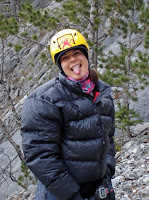 In last week's rumor round-up from the Banff festivals, I forgot one book project: Spanish mountaineer and cover girl Araceli Segarra is doing the illustrations and text for a series of short children's books about the Seven Summits. Here's the lovely Araceli striking a Vogue-worthy pose on Mt. Rundle near Banff.
In last week's rumor round-up from the Banff festivals, I forgot one book project: Spanish mountaineer and cover girl Araceli Segarra is doing the illustrations and text for a series of short children's books about the Seven Summits. Here's the lovely Araceli striking a Vogue-worthy pose on Mt. Rundle near Banff.
Posted by
Dougald MacDonald
at
1:16 PM
0
comments
![]()
![]()
Tuesday, November 13, 2007
The Rumor Mill
While I was in Banff, I heard about a few interesting books and other projects in the works. If I’m saying something I shouldn’t here…oops.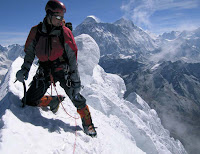 Bernadette McDonald, the former queen bee of the Banff festivals, is soon to publish a biography of Tomaz Humar. The book now needs a postscript since the Slovenian's recent solo ascent on the right side of Annapurna’s south face—a terrific nyah-nyah to detractors after his 2005 rescue from Nanga Parbat.
Bernadette McDonald, the former queen bee of the Banff festivals, is soon to publish a biography of Tomaz Humar. The book now needs a postscript since the Slovenian's recent solo ascent on the right side of Annapurna’s south face—a terrific nyah-nyah to detractors after his 2005 rescue from Nanga Parbat.
A book about Southern California’s Stonemasters in the ’70s, with Dean Fidelman photos and John Long text, will be published by Mountain Gear. Interesting how it takes gear makers and sellers to bring certain books on climbing to market these days, eh? (See also Glen Denny’s Yosemite in the Sixties, a Banff prize winner published by Patagonia.) The risk-averse Mountaineers sure as hell aren’t going to do it.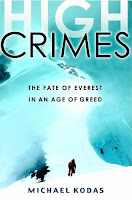 The climbing book likely to get the most mainstream attention in 2008 is High Crimes: The Fate of Everest in an Age of Greed, by the Hartford Courant reporter Michael Kodas. Based on two Everest expeditions and a bunch of independent reporting, it will cover thefts, guides who don’t exactly have the guiding spirit, and other malfeasance on the Big E. It’s slated to be released by Hyperion in early 2008.
The climbing book likely to get the most mainstream attention in 2008 is High Crimes: The Fate of Everest in an Age of Greed, by the Hartford Courant reporter Michael Kodas. Based on two Everest expeditions and a bunch of independent reporting, it will cover thefts, guides who don’t exactly have the guiding spirit, and other malfeasance on the Big E. It’s slated to be released by Hyperion in early 2008.  A possible sleeper is Nick and Betsy Clinch’s book about the Littledales, an English couple who made a remarkable journey through Central Asia in 1896, eventually coming within 45 miles of Lhasa before being turned away. Through a Land of Extremes will be published in the UK in December; no U.S. publisher yet.
A possible sleeper is Nick and Betsy Clinch’s book about the Littledales, an English couple who made a remarkable journey through Central Asia in 1896, eventually coming within 45 miles of Lhasa before being turned away. Through a Land of Extremes will be published in the UK in December; no U.S. publisher yet.
The Irish climbing writer Niall Grimes is ghost-writing an autobiography of the English climber Jerry Moffat. Or maybe it’s the other way around. It was a late night at the pub.
Let’s see, what else? Chis Altstrin, the young filmmaker who created Higher Ground, is doing a documentary about the first ascent of Supercrack, the crack climb that introduced Indian Creek (and desert climbing in general) to the world. And Julie Kennedy, the business brains behind Climbing magazine in the Michael Kennedy era, is launching a small film festival in Carbondale, Colorado, in May.
Posted by
Dougald MacDonald
at
8:06 PM
0
comments
![]()
![]()
Friday, November 09, 2007
Cluckers
 Clucking = climbing + f***ing. This X-rated spoof video, produced by the MTV show "Strutter" in the U.K., is clucking hilarious. It's from an ongoing series on "sextreme sports."
Clucking = climbing + f***ing. This X-rated spoof video, produced by the MTV show "Strutter" in the U.K., is clucking hilarious. It's from an ongoing series on "sextreme sports."
Posted by
Dougald MacDonald
at
2:18 PM
1 comments
![]()
![]()
Books to Read, Films to See
I served on the jury for the Banff Mountain Book Awards this fall, and for the most part it was a real pleasure. Considering my line of work, I don’t read all that many climbing books. In my off hours, I tend to prefer non-mountaineering subjects; the last Everest book I read was Into Thin Air. And so it was great to be forced into reading a wide range of new mountain books. I was pleasantly surprised by how much I enjoyed these, including several new works about Everest, a subject that would seem to offer no new ground whatsoever.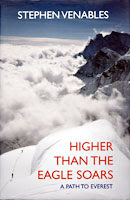 You can see which books we selected for prizes here. Among them, my favorite was Stephen Venables’ Higher Than the Eagle Soars, which, despite its hackneyed title, is a superb book. It’s not really great literature (though it won our votes in the Mountain Literature category), but it’s a damn good read, especially for American readers, who likely haven’t followed Venables’ career as closely as the Brits have. Mostly, I appreciated Venables' ability to express his great love of being out in the mountains, which shines through these stories despite some truly miserable experiences. Throughout I was reminded of Mallory’s quote: “What we get from these adventure is just sheer joy.”
You can see which books we selected for prizes here. Among them, my favorite was Stephen Venables’ Higher Than the Eagle Soars, which, despite its hackneyed title, is a superb book. It’s not really great literature (though it won our votes in the Mountain Literature category), but it’s a damn good read, especially for American readers, who likely haven’t followed Venables’ career as closely as the Brits have. Mostly, I appreciated Venables' ability to express his great love of being out in the mountains, which shines through these stories despite some truly miserable experiences. Throughout I was reminded of Mallory’s quote: “What we get from these adventure is just sheer joy.” I saw quite a few films in Banff, but only a couple stood out. One was King Lines, the new Josh Lowell and Peter Mortimer film about Chris Sharma. This film raises the bar for rock climbing movies by many notches, with superb camera work and production, and a decent story line. And it doesn’t hurt that Sharma is an extraordinarily charismatic individual, though I did tire of his martial-arts screams on every hard move. It made me wonder what he sounds like when…well, never mind.
I saw quite a few films in Banff, but only a couple stood out. One was King Lines, the new Josh Lowell and Peter Mortimer film about Chris Sharma. This film raises the bar for rock climbing movies by many notches, with superb camera work and production, and a decent story line. And it doesn’t hurt that Sharma is an extraordinarily charismatic individual, though I did tire of his martial-arts screams on every hard move. It made me wonder what he sounds like when…well, never mind.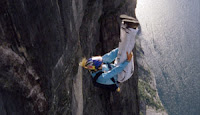 Unfortunately, I missed the film getting the most buzz at Banff: 20 Seconds of Joy, about the Norwegian B.A.S.E. jumper Karina Hollekim. From what I heard, this is a must-see—it won both the Best Film on Mountain Sports and the People’s Choice awards, and people couldn't stop talking about it.
Unfortunately, I missed the film getting the most buzz at Banff: 20 Seconds of Joy, about the Norwegian B.A.S.E. jumper Karina Hollekim. From what I heard, this is a must-see—it won both the Best Film on Mountain Sports and the People’s Choice awards, and people couldn't stop talking about it.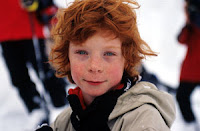 I did see and will highly recommend another winner, Nine Winters Old. This beautifully shot film is a love story about winter and snow. In it’s pace and style, it’s the anti–Warren Miller movie, and maybe you have to be in the right mood for it to hit the mark, but it’s hard to imagine someone who loves skiing not loving this movie.
I did see and will highly recommend another winner, Nine Winters Old. This beautifully shot film is a love story about winter and snow. In it’s pace and style, it’s the anti–Warren Miller movie, and maybe you have to be in the right mood for it to hit the mark, but it’s hard to imagine someone who loves skiing not loving this movie.
I’ve now been on a book jury (Banff) and a film jury (Vancouver), and on the whole I’d say the film gig is way more fun. The book awards did force me to read a bunch of books I’d never have gotten to otherwise, and the discussions with fellow jury members Ed Douglas and Will Gadd were lively and interesting, but after a full work day of writing and editing it could be awfully hard to psyche up to read more mountain stories. On a film jury, well, you’re just watching movies, and when you get to the final round you hang out with other film people and (at least at Vancouver) drink beer while you’re doing it. Can’t beat that.
Posted by
Dougald MacDonald
at
6:52 AM
0
comments
![]()
![]()
Wednesday, November 07, 2007
Dumby Dave
 My feature profile of the Scottish all-arounder Dave MacLeod made the cover of Climbing magazine this month (No. 262). Dave is one of the world’s boldest rock and ice climbers, made famous by the first ascent of Rhapsody (5.14c R/X) after two years of effort, and I was quite tickled with my lede: “I studied him, sure I did, but I couldn’t see that Dave MacLeod walked peculiarly or sat down carefully or anything else that might indicate he has bigger balls than the rest of us.” Climbing.com has posted the story, so you can read it online.
My feature profile of the Scottish all-arounder Dave MacLeod made the cover of Climbing magazine this month (No. 262). Dave is one of the world’s boldest rock and ice climbers, made famous by the first ascent of Rhapsody (5.14c R/X) after two years of effort, and I was quite tickled with my lede: “I studied him, sure I did, but I couldn’t see that Dave MacLeod walked peculiarly or sat down carefully or anything else that might indicate he has bigger balls than the rest of us.” Climbing.com has posted the story, so you can read it online.
Dave’s an interesting character: obsessive and yet humble and thoughtful. I don’t think any climber who’s 29 and does “death routes” is fully in touch with what he’s doing. And even though few talk/write about it as articulately as Dave does (check out his blog), there are some things he can't or won't express. I never felt like I fully got to the bottom of what motivates him, but the story reflects everything I could learn.
Posted by
Dougald MacDonald
at
6:11 AM
0
comments
![]()
![]()
Tuesday, November 06, 2007
Secrets of the Stars
Last week I was in Banff for the annual book and film festivals; I was on the book jury, and I'll try to post some comments on various books and a few films in the next couple of days.
The Banff area was dry for early November and not much ice was in shape—unless, that is, you're a visiting superstar from Switzerland, in which case you climb one or two classic testpieces nearly every day. Simon Anthamatten and Ueli Steck have repeated half a dozen major Rockies routes and put up one of their own, in spite of the lean conditions. Last week they climbed a super-thin Sea of Vapors despite having forgotten all of their rock gear. "It was scary!" said Steck. This from the man who soloed the Eiger in less than four hours and fell more than 1,000 feet off the south face of Annapurna last spring without serious injury.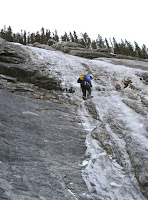 On Friday, John Harlin, Mark Jenkins, Araceli Segarra, and I snuck away from the festivals for a day of climbing. Only one route in the immediate area seemed to be in shape for mortals like us: Christmas Present (III WI3 R), a rarely formed climb low on Mt. Rundle. This was a fun short route, with some easy rock climbing leading to two long, thin pitches, the first of which had essentially no protection. Perhaps the best part of the climb was the descent through a forest whose snow-free floor was a thick carpet of emerald moss. Enchanting.
On Friday, John Harlin, Mark Jenkins, Araceli Segarra, and I snuck away from the festivals for a day of climbing. Only one route in the immediate area seemed to be in shape for mortals like us: Christmas Present (III WI3 R), a rarely formed climb low on Mt. Rundle. This was a fun short route, with some easy rock climbing leading to two long, thin pitches, the first of which had essentially no protection. Perhaps the best part of the climb was the descent through a forest whose snow-free floor was a thick carpet of emerald moss. Enchanting.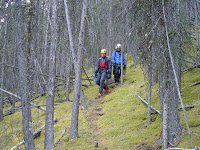 Before this climb, we had met Anthamatten and Steck at the parking lot, outside a gate by the bridge over the Bow River. Until this gate was locked, you could drive another two miles, saving 40 minutes of walking. We chatted with the Swiss stars, who, it turned out were about to climb Sacre Bleu and Ten Years After in a single day—a huge outing. I turned my attention to my pack for a moment, and when I looked up the Swiss were trotting briskly toward the gate, their full packs bouncing on their backs. "Wow, those guys are impressive," I thought. "They run to their climbs!"
Before this climb, we had met Anthamatten and Steck at the parking lot, outside a gate by the bridge over the Bow River. Until this gate was locked, you could drive another two miles, saving 40 minutes of walking. We chatted with the Swiss stars, who, it turned out were about to climb Sacre Bleu and Ten Years After in a single day—a huge outing. I turned my attention to my pack for a moment, and when I looked up the Swiss were trotting briskly toward the gate, their full packs bouncing on their backs. "Wow, those guys are impressive," I thought. "They run to their climbs!"
"So," I said to my friends, "I guess that's how they get so much done in a day."
Just then, we noticed that a garbage truck had pulled through the gate and sat idling on the Bow bridge. Simon and Ueli ran up to the driver, exchanged a few words, and, before we could move, climbed onto the little ladders on the back like garbage men, and rode off to begin their approach. The Swiss were not only stronger than us. They also were smarter.
Posted by
Dougald MacDonald
at
6:01 AM
1 comments
![]()
![]()
Monday, October 29, 2007
Chamonix: A Sweet Finale
After our Walk of Shame to the Cosmiques hut following the abortion at the base of Mont Maudit, we ordered a bowl of soup and a panaché (lager and lemonade), and then I took a two-hour nap. I woke up for a cosmic dinner and then went right back upstairs for a blissful 10 hours in the rack. In the morning, I was a new man.Anything we could do on our final day in Chamonix would have to be short and close to the hut because we had to catch the last lift down in order to make it to our flights from Geneva the next morning. The night before, we’d had dinner with Kathy Cosley, an American guide who lives in Europe and was heading up Mont Blanc with a client. I was eager to get her opinion on what to do, in part because I'd already studied the website that her husband, the guide Mark Houston, had put together; this superb site is packed with detailed route descriptions and photos from many Alpine classics, and I highly recommend it to anyone planning a trip. Cosley recommended the Chèré Couloir on the Triangle du Tacul for a good quick route, and so, as the morning clouds lifted and a stiff wind buffeted the hut, that’s what we did.
The Triangle is the site for half a dozen “sport ice” routes, including several short but very beautiful goulottes (narrow couloirs). Although the climbing on some of these is difficult, and the approach and descent are threatened by serac fall and all the other dangers of Alpine routes, they’re “sport ice” because they’re so close to the hut and lift, and because you can just rap down whenever the going gets too tough or you run out of time. John and I climbed three long, excellent pitches of sticky, one-hit ice on the beautiful Chèré Couloir. We had planned to continue up the easier mixed ground to the top, but at the third belay, after all the steep ice, John suggested we might just have time for another route if we rapped now.
Specifically, we thought we might just have time to climb the Eperon des Cosmiques (Cosmiques Spur), a five-pitch rock climb that leads to the upper Cosmiques Arête, a classic easy mixed ridge which in turn regains the Aiguille du Midi summit, where we had to go anyway to ride back down to Chamonix. It would surely beat a snow slog. John, for whom the easy way is never sufficient, suggested a mixed "shortcut" along a ridge to return from the Chèré Couloir to the hut instead of the easy snow walk, and by the time we got there it was after noon.
The last lift down from the Aiguille de Midi was at 5:30. We could not afford to miss this lift and bivouac again. The rock climb was looking a bit dubious; perhaps we ought to just climb the more straightforward Cosmiques Arête and make sure we caught the lift.
“We've reached the age that we don’t have to do stupid things that we’ll regret later,” John said, ignoring the fact that we’d already done one stupid thing on this trip that we’d regret later. But when we walked down the hill from the hut, we hardly needed to speak to make the decision to walk over to the base of the bigger climb, the Eperon des Cosmiques. John quickly did the math: If we could clear the crux roof halfway up the climb by 3 p.m., that ought to give us enough time to finish the route and the ridge above and still make the lift. If we weren’t there by 3, we’d rap off and slog up the snow slopes to the lift station. The race was on.
Climbing granite in big boots while wearing a moderately heavy pack is never much fun, even if it’s relatively easy, well-protected granite like our route on the Eperon des Cosmiques. But, although we were huffing and puffing as we hurried up the steep jam cracks, John and I were having a blast: At last we were moving well and feeling somewhat competent. We quickly caught and passed a pair of climbers on another, easier route to our left.
With a quick yank on the sling conveniently dangling from the route’s big roof (5.10), we were past the crux. Two more pitches brought us to the snow at the top.
Here, we were about midway up the Cosmiques Arête. A huge line of climbers had started up the route earlier, and we could see many of them ahead of us on the finishing pitches. But, with our late and unorthodox approach, we found ourselves all alone on this crowded classic. In mid-September, the ridge wasn’t as pretty as it might have been when covered with more snow. But it was still great fun weaving around the huge gendarmes and climbing up and down steep little steps, one foot on rock, one on ice, in the classic style. Nearby we could see two climbers perched dramatically on the main south buttress of the Aiguille du Midi.
We moved together with a shortened rope between us, and soon we were at the base of the final step, where a short, fixed aid step off a giant bolt and a little chimney pitch gained the final moves: a steel ladder bolted to the tourist complex on the summit ledges of the Aiguille de Midi.
It felt good to have actually climbed something, no matter how trivial these climbs had been compared with our original goal. John, to his everlasting credit, was all smiles. I was psyched, too, but also a bit sad: My unexpected European vacation was over.
To read the first of these reports from the Alps, click here.
Posted by
Dougald MacDonald
at
6:24 PM
4
comments
![]()
![]()
Friday, October 19, 2007
Cursed in Chamonix
John Harlin and I had only three days to get something done in the mountains before we had to fly out of Geneva. We were overloaded with possibilities: back to Grindelwald for the Mittellegi Ridge on the Eiger or the beautiful Schreckhorn; to Zermatt or Zinal for a route on the Matterhorn or the Zinal Rothorn; or to Chamonix for…well, for a hundred different possibilities. In the end, the unmatched convenience of Chamonix climbing, combined with a free lift over to France with Jerry and Daron Robertson, tipped the balance in favor of Chamonix-Mont Blanc.I hadn’t been to Cham in 20 years, and the last time had been a learning experience. We were there in May, and the weather was iffy. More importantly, we didn’t have skis and we were too broke or cheap to rent them. I remember sleeping at a jam-packed Argentiere Hut, the first stop on the Haute Route, at the beginning of a holiday weekend, and out of at least a 150 people at the hut we were the only ones without skis.
This time, the stars were lining up. The weather was perfect, and Roger Payne, who’d just been guiding on Mont Blanc, had told us conditions were excellent on the high-altitude mixed routes, which is just what we hoped to climb. We were aiming for the Frontier Ridge on Mont Maudit, a 14,648-foot satellite peak of Mont Blanc. The route was No. 50 in Gaston Rebuffat’s Le Massif du Mont Blanc: Les 100 Plus Belles Courses, which placed it right in the middle of the difficulty range for the massif, at least in 1973 when the book was published.It was midafternoon before we’d arrived in Chamonix, sorted a place to store our bags and computers, bought a bit of food and a fuel cartridge for John’s JetBoil, and made our way to the Aiguille du Midi tram. There was just one problem: When we’d called for reservations at the Refuge des Cosmiques, the hut where we planned to spend the night, we learned that it was full. Well, no matter, we thought: We’ll do the approach in the evening, stay at a bivouac hut right on the Frontier Ridge, and that way we’d do the beautiful three-hour walk across the glacier in daylight instead of the predawn blackness.
After riding the stupendous Aiguille du Midi lift, which gains about 9,000 vertical feet in two stages, we geared up, tiptoed down the frightening snow arête outside the Midi, and set off across the glacier. This was easy going, but it was a long ways, and it was after 7 p.m. when we neared the base of our ridge. We bumped into two Italian guys headed down, and John showed them the map and asked which ice gully led to the hut. Now’s probably the time to say there were actually two huts shown on our map, the Col de la Fourche bivouac hut and a second hut, a bit farther away from the start of the route but still on the ridge, called the Refuge Ghiglione. The Italians had something emphatic to say about one of these huts, but given the language barrier we couldn’t make out which—or what the issue was.
To reach the ridge, you have to climb about 400 feet of moderately steep alpine ice. As we neared the obvious ice slope leading to the Col de la Fourche, we saw at least six climbers above us at the col or finishing the ice. Having done no research on this bivy hut (stupid, stupid!), we weren’t sure how big it was or even whether it had bunks or blankets. Since we had neither pads nor bags, we definitely wanted blankets. So, we opted to shift course and climb a different ice gully to reach the Ghiglione hut.
It was pitch dark by the time we reached the hard-packed snow arête leading to the Ghiglione. John was leading and I was concentrating on moving precisely, since we were roped up but had no gear between us. John paused on top of a big cornice and yelled back, “This doesn’t look good!” No it didn’t. Turns out the Refuge Ghiglione had been removed in the mid-1990s because its foundation was eroding, but for some reason it was still on the maps. (The photo at right shows the hut's spectacular setting, cantilevered over the Brenva Glacier, sometime in the 1980s.) All that is left now is a steel platform. We were stuck and we began to prepare for a very cold mid-September night. Fortunately, we had a stove and bivy sacks, and even more fortunately the wind stayed calm overnight. John soon discovered that the big white mound beside the platform that we thought was snow was actually old fiberglass insulation, so we stripped off sheets of this and made fluffy mattresses to lie on—good for insulation, bad for the lungs. We knew we’d survive the night, but we also knew we were going to be miserable for the next 8 hours or so.
No it didn’t. Turns out the Refuge Ghiglione had been removed in the mid-1990s because its foundation was eroding, but for some reason it was still on the maps. (The photo at right shows the hut's spectacular setting, cantilevered over the Brenva Glacier, sometime in the 1980s.) All that is left now is a steel platform. We were stuck and we began to prepare for a very cold mid-September night. Fortunately, we had a stove and bivy sacks, and even more fortunately the wind stayed calm overnight. John soon discovered that the big white mound beside the platform that we thought was snow was actually old fiberglass insulation, so we stripped off sheets of this and made fluffy mattresses to lie on—good for insulation, bad for the lungs. We knew we’d survive the night, but we also knew we were going to be miserable for the next 8 hours or so. I sure admire people who can suffer through an unplanned bivy and then snap to it the next morning, climbing hard. I felt like crap in the morning—sleepless, dehydrated, and with a touch of altitude sickness—and once we got under way we quickly made another tactical blunder. We should have rappelled back down the ice we’d climbed the night before and then climbed back to the ridge to get en route. Instead, we tried to traverse along the side of the ridge, which required tedious, moderately difficult mixed climbing, plus a couple of lowers and rappels when we got off route. Had we actually climbed the Frontier Ridge of Mont Maudit, I’m certain we would have done the crux before we had even started the actual route. As it was, we never even made it to the Col de la Fourche. As a hot sun beat down upon us from a windless blue sky, I pulled the plug and we bailed. We rapped to the glacier and began the exhausting Walk of Shame to the Cosmiques Hut.

Mont Maudit, by the way, means "cursed mountain." Next up: Redemption! To read the first of these reports from the Alps, click here .
Posted by
Dougald MacDonald
at
4:00 PM
2
comments
![]()
![]()
Wednesday, October 17, 2007
The Robbins Route
Our organized media tour in Switzerland had ended and the leashes were off: In other words, it was time to climb.
John Harlin wanted to return to the Tour d’Aï above Leysin, where he had lived for several years during the 1960s, and where his father had started the International School of Mountaineering. For a brief time, because of the senior Harlin's influence and his need for instructors at the new school, this tiny town was one of the most important centers of climbing in the Alps. In particular, it was the center of American influence, when Harlin, Tom Frost, Gary Hemming, Royal Robbins, and others brought Yosemite skills to the Alps and climbed major new routes like the south face of the Fou and the American Direct on the Drus—perhaps the only time when Americans made a significant mark on Alpine history.In 1964, John Harlin II climbed the first two pitches of a steep limestone route on the Tour d'Aï. Harlin veered off to the left below a final headwall. The following summer, Royal Robbins was running Harlin's climbing school and the two were working on the American Direct. Between forays to Chamonix, Robbins repeated the Harlin route on the Tour d'Aî and then forged straight up the overhanging headwall, using a few points of aid. A short time later, he returned with George Lowe and led the entire route all free at around 5.11b. In 1965, this may have been the hardest free pitch in the world, and Robbins must have done it with almost no pro in the first half of the lead. I'll bet only a handful of American climbers have ever even heard of this route, but it was a tour de force.
John Harlin III had made a date to meet up with Jerry Robertson, who was John Harlin II's partner during his first attempt on the Eiger in the early 1960s, and to climb the Harlin/Robbins route with Jerry’s son, Daron. I tagged along, and it was a fantastic experience.The first two pitches, which John’s dad had climbed, followed a corner and crack system up a vague pillar. We carried some pro, but we didn’t need much: The route had been fully retro-bolted some years earlier. These two pitches could have been protected without bolts, but the second would have required numerous large cams; Harlin's dad had used wooden blocks as “pro” for the wide crack. I wasn’t really sorry to see a good bolt every 10 feet or so.
Daron, a 5.13 climber from Tucson, was our rope gun for the Robbins pitch, and he quickly completed the long, overhanging lead. When I followed, I was blown away by what Robbins had accomplished in the mid-1960s. He would have found almost no protection in the first 30 or 40 feet; above that, although the route followed a series of cracks, the face was so steep that hanging on to place pitons (the only option at the time)
would have been absolutely desperate. Moreover, the climbing was hard. Sustained and fingery, the pitch climbed over two crux bulges, with a sting in the tail in the form of a deceptive pod in the final crack. I could not imagine leading this climb without the bolts. I was happy just to follow it cleanly.
Each of us enjoyed this climb in different ways. Though the climbing was technically easy for Daron, he hadn’t done a multipitch route since he started climbing 10 years earlier. For John, it was a trip down memory lane, and a chance to celebrate the accomplishments of his father. For me, it was a superb and eye-opening climb, my first in Switzerland, and I felt privileged to explore this little-known setting of climbing history. Most climbers are—or should be—familiar with Royal Robbins' ground-breaking climbs in Yosemite: He was the master of big-wall rock craft during the Valley's Golden Age. But our day on Le Tour d'Aï gave me a much greater sense of Robbins' incredible free-climbing prowess. Given modern shoes, protection, and training, what might he have accomplished today?
To go to the start of these reports from Switzerland, click here.
Posted by
Dougald MacDonald
at
9:12 AM
1 comments
![]()
![]()




